C.P. Squires
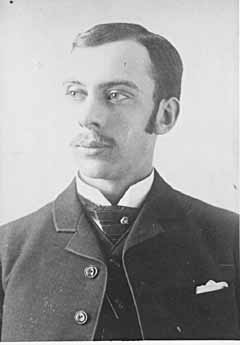
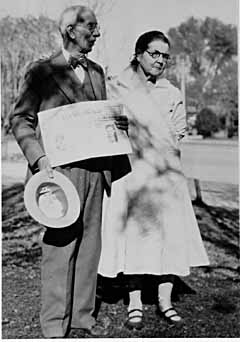

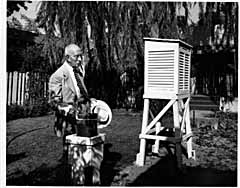
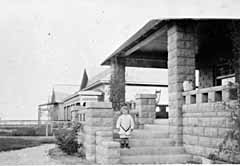
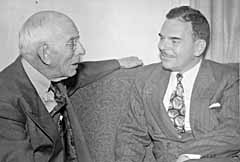

If there is any individual who deserves the title “The Father of Las Vegas,” it is Charles Pember Squires, a native of Austin, Minn., who spent more than 50 years here, building, boosting and ballyhooing his city. Fellow citizens who knew him during that time in Las Vegas greeted him with the sobriquet of “Pop,” and his wife, Delphine, as “Mom.”
Born in 1865, Charley moved with his family to Redlands, Calif., where he set himself up in a real estate and title insurance business. Once established, he proposed by mail to his high school sweetheart, Delphine Anderson, and they were married in August of 1889. Their first two children, Florence and James, were born in Redlands.
The panic of 1893 caused a sharp drop in real estate transactions, and C.P. later sold his business.
In 1903, he became secretary and manager of the Union League Club, where he heard about the plans of Sen. William A. Clark to extend his San Pedro and Los Angeles Railroad all the way to Salt Lake City. Part of the plan was to establish a new town in a desert valley that happened to contain quite a bit of water. It had long been known as Las Vegas, “The Meadows.”
Young Squires smelled opportunity. In partnership with J. Ross Clark, Frank Waters and Chris N. Brown, a distant relative of his wife, he borrowed $25,000 from banker John H. Pirtle to establish a bank, a hotel, lumberyard and a real estate firm. He invited Brown to accompany him on an inspection tour of the site. Getting there was a problem. The railroad was using all its cars to carry the equipment needed to lay out and subdivide the town.
“We were free to stow away as best we could on gondola cars loaded with plows, scrapers, wagons and other dirt moving appliances,” Squires recalled.
They set off in February 1905 aboard a Santa Fe passenger train, which dropped them in the desolate desert way station of Dagget, where they would catch a northbound train on the new San Pedro, Los Angeles & Salt Lake Railroad. They had arrived in the afternoon, and the train was not due until the following afternoon. The only refuge from the cold was in a makeshift saloon, where they spent the night huddled around a stove. For this privilege, they had to occasionally buy a couple of shots of the house whiskey, which Squires could describe only as “savage.”
The only spot they could find aboard the train was in a small space at the front of a gondola car, which exposed them directly to the freezing desert night.
After traveling most of the night, the train stopped at a point that Squires later found out was Jean. The conductor ordered them off the train, promising to return. It was several hours later that he returned, with the engine at the rear of the train and a caboose at its front. Squires and Brown were allowed to ride in its relative comfort.
At about 7 a.m., Squires stepped out onto the platform of the caboose and peered out across the wide valley. In the distance, he spotted several tiny white dots.
“What is that?” he asked the conductor.
The conductor cleared his throat and spat vigorously.
“That is Las Vegas,” he replied.
From outward appearances, the landscape was no different than that of a dozen desert valleys. But C.P. Squires was impressed. He didn’t know why.
“Perhaps that bright and glorious morning after the misery of the long night gave this spot a particularly tender place in my heart.”
The only lodging house in town was a tent owned by “Captain” James Ladd, who had a novel way of making sure that his premises were free of lice or other vermin. After he and Brown had checked in, a weary and very dusty teamster arrived. Ladd told him the place was full, but that he could sit over by the stove until a spot came open. He let the man sit for awhile, then beckoned him into the back, where many beds were available. Squires asked him why he had made the man wait, and Ladd explained that if the man sitting by the stove began to scratch, he was persona non grata. If not, he was welcome to pay his $1 and share a bed with another man for eight hours.
Each of Squires’ partners put up $1,250 to capitalize what became known as the First State Bank, and Los Angeles banker John S. Park was brought in to run it. Squires went back to Los Angeles, where he bought a set of books, a desk, chairs and a mighty iron safe, calculated to inspire confidence in depositors. And the bank was in business.
In anticipation of the land sale which was planned for the following May, Squires set about constructing another tent hotel. In comparison to Ladd’s place, it would be a palace. Returning again to Los Angeles, he ordered a custom-made tent with 30 individual rooms. It was also to be equipped with a lobby, beer bar and a cigar stand, and two separate tents which were the kitchen and dining room.
It was a complicated thing, and difficult to erect. As the work was under way, a light but steady rain commenced. It continued all night, and Squires and his help scrambled to keep the mattresses and other gear from becoming soaked and ruined. Finally, soaked, freezing and frustrated, he walked away.
“For my hopes at least, the world was at an end,” he later recalled. “And Las Vegas and the … railroad could go plumb to hell as far as I was concerned.”
As winter turned to spring. It also became apparent that there was a vital piece of the hotel missing, the “fly.” This was a piece of canvas suspended above the actual roof to keep the tent from absorbing and concentrating the sun’s rays inside. On the first hot day of the year, the temperature inside the Hotel Las Vegas, as it was called, reached a balmy 130-plus degrees.
On May 15, 1905, Squires was among the bidders gathered around the platform when the town lots were being auctioned. Among the numerous parcels he purchased were the entire block between Fourth and Fifth streets to be used for residential development.
Within a year, Squires was out of the hotel business — and happily so. John F. Miller had built the Hotel Nevada — and not from textiles.
“We were glad to dismantle our hotel because the winds of 1905-06 were threatening to scatter it over the desert,” said Squires. “Besides, the danger of fire was great.” And by June 1906, he had completed his own home at Fourth and Fremont, and had brought his family to join him.
Las Vegas was not a pleasant place. There was no sewage system, and flies brought on by the proliferation of human and animal waste besieged the town like a plague from the Old Testament. The townspeople got together and passed a law requiring that all privies be enclosed in metal boxes. Since the nearest law was in Pioche, the ordinance was unenforceable, but Squires made it his business to see that it was observed, and was largely successful.
Of greater concern, however, were the fires that kept erupting, usually from upset kerosene lamps. Squires got to work on his next big project, electrifying Las Vegas. The Consolidated Power and Telephone Co. was incorporated March 20, 1906, with Chris Brown as president, Robert Graham as vice president, John S. Park as treasurer and Squires as secretary, the position he always seemed to seek, probably because it put him closer to the action than anyone else.
For the electrification project, he first set up a distribution system — the power poles and wires. At first, the system operated on low-voltage direct current purchased from the Las Vegas Ice Company. Squires purchased a pair of 90-horsepower gasoline engines and a pair of 50-kilowatt Westinghouse generators, capable of producing 110-volt alternating current, along with 50 telephones, enough for everyone in town who wanted one.
But by 1908, the town seemed to have withered up and died. Another “panic” had hit the nation. Investors were wary; money was tight. Squires traveled back to Minnesota, visited with old friends, trying to interest investors in the promising young desert town, specifically in the Potosi Mine. He visited Minneapolis and Chicago with no luck.
“I finally gave it up and reached home about May 22, 1908, broke, tired, discouraged and at war with the world in general, not knowing what to do or try to do. It was a black-looking world and poor, sick Las Vegas was about the lowest in spirit that a town could get and still keep a post office. There were still some people here, most of them unable to get away and having no other place to land which was any better. The train crews operating the railroad were the only people who had any income, and that none too generous.”
Squires was fondly recalling his “good old job” with the Title Insurance and Trust Co. in Los Angeles, and was “already cogitating as to whether I could get (it) back.”
It was against this backdrop that Charles Pember Squires, now nearing age 40, almost missed the opportunity that would make his fortune.
In 1905, there had been three newspapers in Las Vegas; the Las Vegas Times, The Las Vegas Advance and The Las Vegas Age. The Advance lasted only a couple of months. The publisher of the Las Vegas Times decided that Las Vegas was hopeless, and moved his newspaper to Caliente. This left The Las Vegas Age, owned by C.W. Nicklin.
Nicklin was anxious to get out of town. He approached Squires and asked him if he would like to enter the exciting world of journalism.
Squires had an immediate answer.
“What on earth would I do with a newspaper? I have troubles enough already,” he cried.
The next day, Nicklin came again, this time offering The Age to Squires at a deep discount, if he would take it right away. He “firmly and very decisively” declined the offer.
“But something had started a train of thought which I was unable to sidetrack. Now, just suppose I had a newspaper in Las Vegas, perhaps I could help revive the poor, sick little town.”
On his third visit, Nicklin offered Squires the newspaper at the “ridiculously low price” of $2,300. Squires hesitated, but ended up accepting the deal. Charles Pember Squires now had what his hero, Teddy Roosevelt, would call a “Bully Pulpit” for expounding his views, and he used it. But before he began crusading in earnest, he began to improve the little paper. Sometime between 1908 and 1909, he began his tenure as Las Vegas’ official and unofficial weather observer, and installed a small weather station behind the newspaper office at 411 E. Fremont St. The Age now was able to report the weather, and on July 26, 1931, he logged the highest recorded temperature ever — 118 degrees.
To a newspaperman of his generation, it would have been unthinkable not to become directly involved in civic matters, including politics. In 1907, he served on the finance committee of the Lincoln County Division Club, which advocated breaking off the southern half of the enormous county and creating a new one.
In 1909, the Nevada Legislature approved the split, but it carried a heavy cost. The indebtedness of Lincoln County was to be divided between Lincoln and Clark counties. This included the debt from the notorious “Million Dollar Courthouse” in Pioche. Needlessly elaborate for its time and place, the courthouse had cost $20,000 to build in 1871, and mismanagement of the debt service had swelled the debt to $640,000 by 1909. The cost was split in proportion to the assessed valuation of each county, so the fledgling county began life $430,000 in debt. Furthermore, noted Squires, the new county had “no money, no county property. Lincoln County had its courthouse. It was a bitter pill, but county division was worth it.”
In late 1910, Squires and three other leading citizens drafted Las Vegas’ city charter and marshalled it through the legislative process. It was signed by Gov. Tasker L. Oddie on March 17, 1911.
In 1920, Squires embarked on the project that would ultimately insure the survival of Las Vegas, and likewise insure his place as a major figure in the history of Nevada.
A promotional organization, the League of the Southwest, consisting of representatives from Southern California and Nevada, met in Los Angeles in April of 1920 to discuss the possibility of developing the Colorado River — specifically building a dam on it.
Squires approached Nevada Gov. Emmett Boyle and asked him to lend his support to the effort. Boyle thought the proposal a little far-fetched, and declined to personally involve himself in it. But he deputized Squires.
“I appoint you my personal representative and will stand behind whatever you see fit to do,” the governor declared. The first thing Squires did was pick three other Las Vegans, Dr. Royce W. Martin, James Cashman and E.W. Griffith. Boyle confirmed all of them as delegates to the convention of the League of the Southwest.
Squires was appointed to the committee on resolutions, chaired by Gov. D.W. Davis of Idaho. The first day of the convention was given over to protests from those who believed that building a dam would flood the Grand Canyon. At the end of the second day, no resolutions had emerged.
“Nobody had any ideas,” Squires recalls. Davis had noticed that Squires, the newspaperman, had been taking copious notes, and he suggested that he be directed to write a resolution that evening. He spent most of the night drafting it, and it was accepted and adopted with only minor changes the following day.
The resolution called for a high dam to be built at or near Boulder Canyon “in order to preserve the Imperial Valley from destruction and to provide water for the growing cities of the Southwest.”
Another meeting of the league was held in Denver, and it was there that Squires pointed out that the U.S. Constitution allows states to form treaties or compacts among themselves. The governor of Colorado volunteered that he had a man in his office, Delph Carpenter, who was something of an authority on interstate compacts. Carpenter explained that it would be virtually impossible for a private enterprise to finance and build a dam on the Colorado River. The states would have to agree upon a compact and put it before the U.S. Congress.
“We knew then that our dreams for early construction of a dam in the Colorado River were hopeless,” Squires said.
In January 1921, the legislatures of each of the seven states adopted a resolution asking that a commission be formed to hammer out the necessary interstate compact.
Commerce Secretary Herbert Hoover represented the federal government, and was chairman of the Colorado River Commission. Nevada State Engineer James Scrugham, along with Ed W. Clark and Squires were appointed to represent Nevada.
The first meeting of the Colorado River Commission was held at the Bishop’s Lodge in Santa Fe, N.M., in early 1922.
After more than 20 days in session, Hoover managed to get the delegation — with the exception of Arizona — to agree on a Colorado River Compact, which allocated water to each of the states, and set forth a basic plan of action. It was ratified by six of the seven state legislatures in 1923.
In early 1928, the commission again met at Santa Fe, this time determined to bring Arizona into the fold. It was finally decided that the six states that were in agreement could sign the compact, and Arizona could join when it had a change of heart. By the end of that year, the Swing-Johnson Bill, named for Rep. Phil Swing and Sen. Hyrum Johnson, both of California, had been passed into law by Congress.
In 1940 Squires sold The Las Vegas Age to Frank Garside, who then owned the Las Vegas Review-Journal.
In November of 1944, a woman named Margaret Folsom bought a 40-acre tract of land far out on the Los Angeles highway from Squires for $7,500. He had originally paid $8.75 an acre for it. The land was then conveyed to a Los Angeleno named Billy Wilkerson who began work on a very large hotel. When Wilkerson, a heavy gambler, ran out of funds to complete the project, a handsome gangster named Benjamin “Bugsy” Siegel took control of the project. Long after the Fabulous Flamingo had been built, and Bugsy had been whacked, Squires recalled Siegel as “a pleasant chap.”
Squires had the good fortune not shared by many of the other 1905 pioneers; he lived long enough to see the fly-infested tent town grow into a booming city, which was continuing to boom when he died in 1958, at age 93.
In a page one obituary in the Las Vegas Sun, reporter Bob Faiss summarized Charles P. Squires’ contributions concisely and accurately.
“It seems strange that Las Vegas, a modern boomtown … established as one of the vacation centers of the world, should owe so much to the foresight of one man. But there is little we have today that wasn’t given an initial shove by ‘Pop’ Squires.”
Part I: The Early Years












